Unit 6 When was it invented?Section A (3a~4c) 课件(共30张PPT)2023-2024学年人教版英语九年级全一册
文档属性
| 名称 | Unit 6 When was it invented?Section A (3a~4c) 课件(共30张PPT)2023-2024学年人教版英语九年级全一册 | 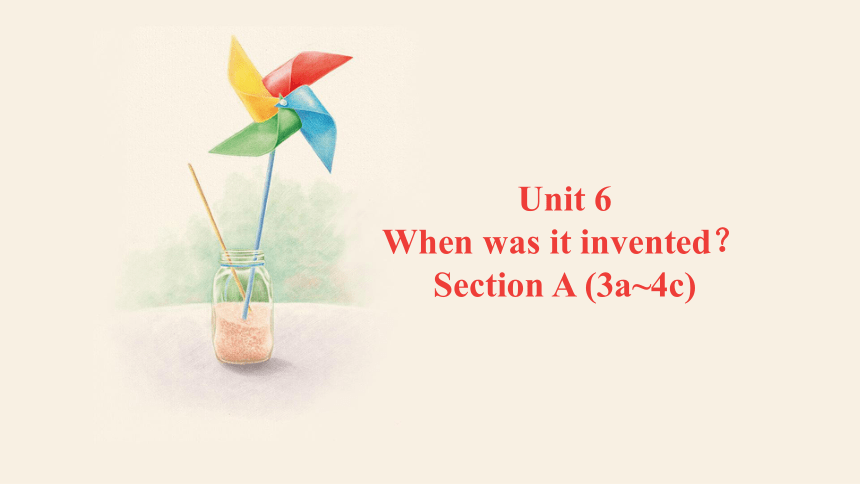 | |
| 格式 | pptx | ||
| 文件大小 | 4.5MB | ||
| 资源类型 | 教案 | ||
| 版本资源 | 人教新目标(Go for it)版 | ||
| 科目 | 英语 | ||
| 更新时间 | 2023-12-13 13:23:38 | ||
图片预览

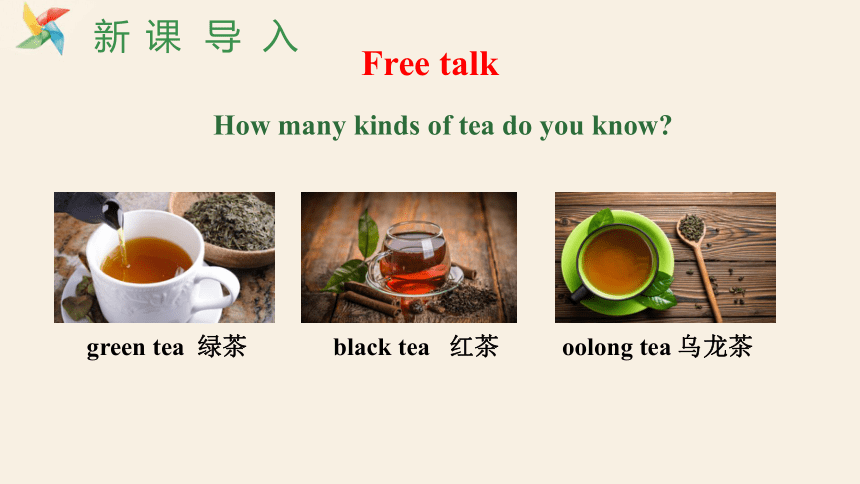
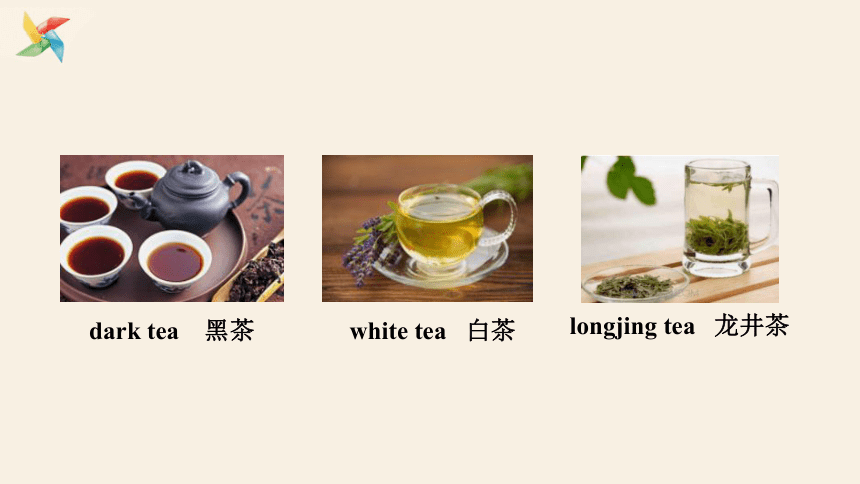

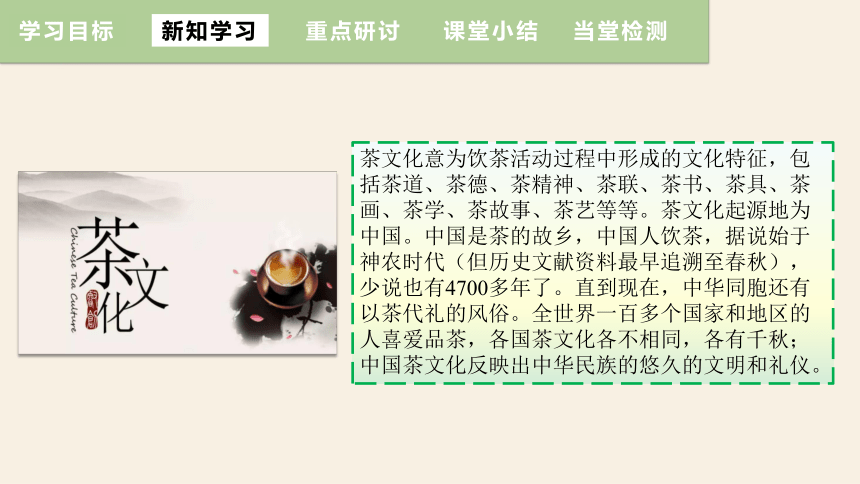
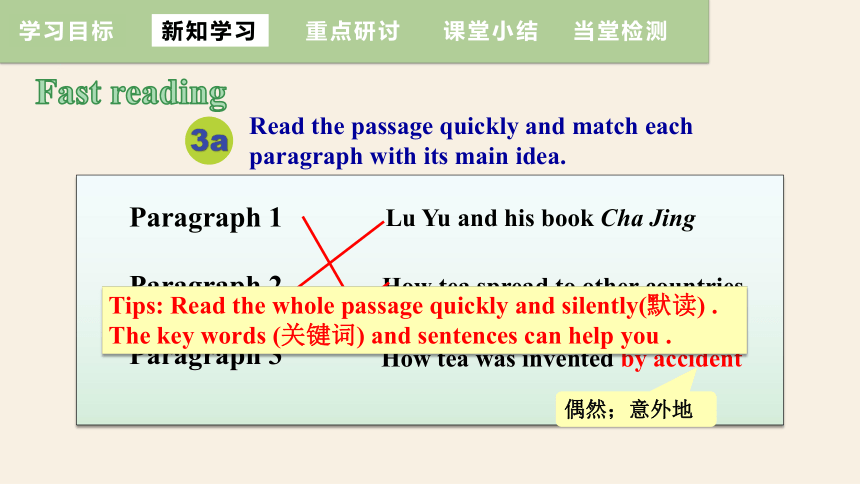
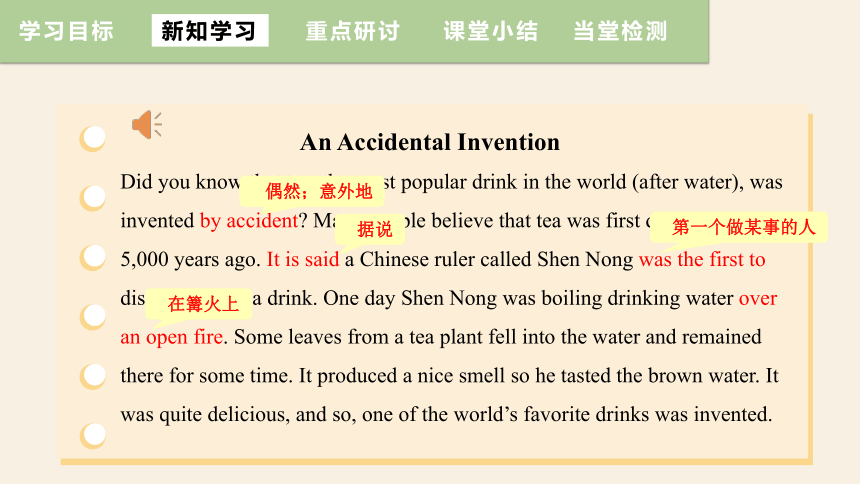
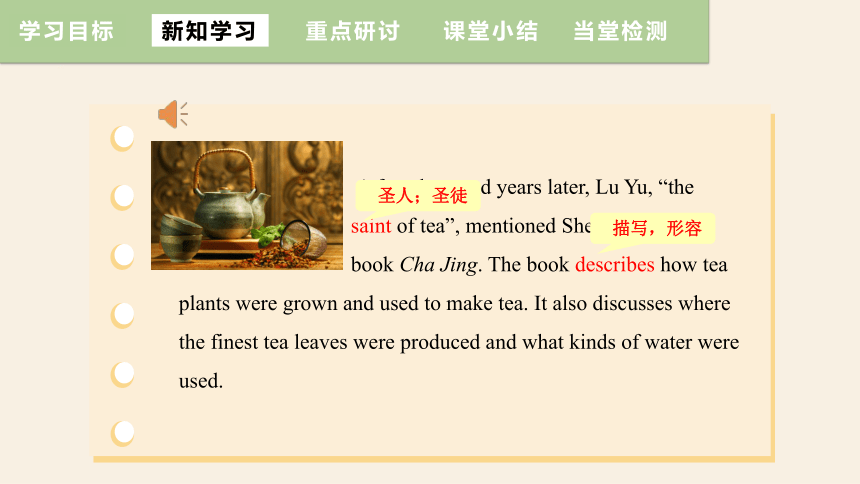

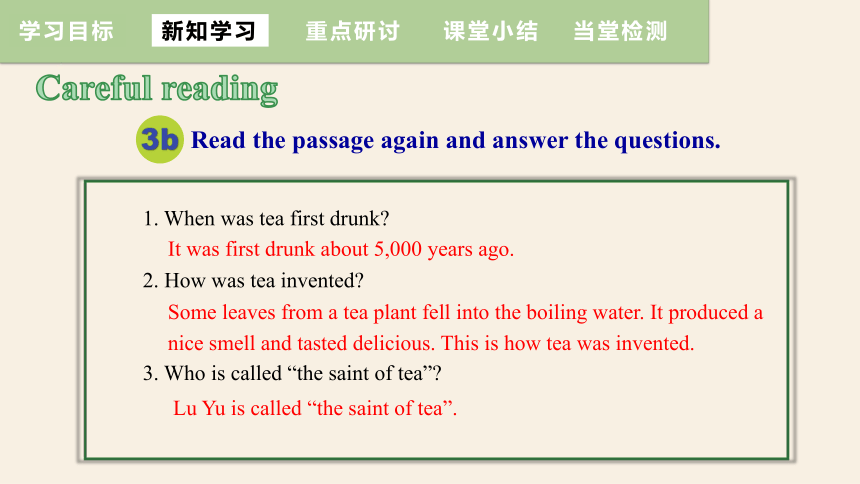

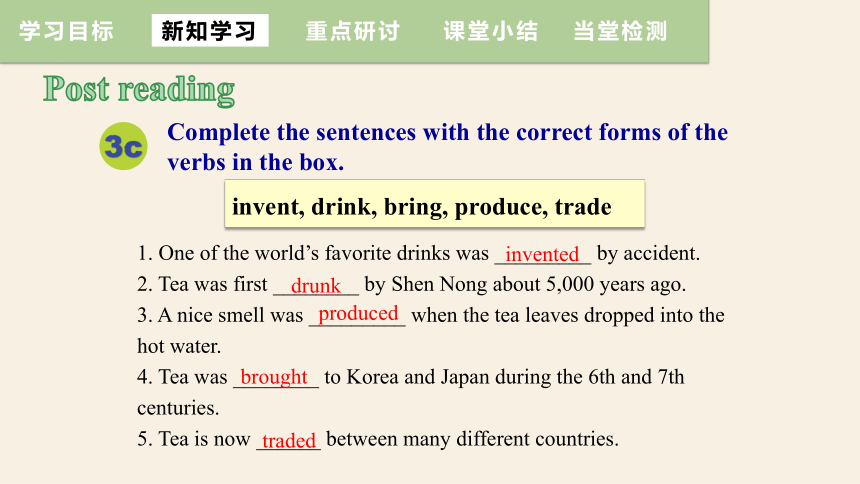
文档简介
Unit 6
When was it invented?
Section A (3a~4c) 课件(共30张PPT)
新
课
导
入
Free talk
How many kinds of tea do you know
green tea 绿茶
black tea 红茶
oolong tea 乌龙茶
dark tea 黑茶
white tea 白茶
longjing tea 龙井茶
Language Goal
新知学习
课堂小结
当堂检测
学习目标
重点研讨
1.能熟悉并能正确运用本课时的重点单词和短语
2.能通过阅读了解茶叶的发明与传播
3.能正确运用一般过去时的被动语态
新知学习
课堂小结
当堂检测
学习目标
重点研讨
茶文化意为饮茶活动过程中形成的文化特征,包括茶道、茶德、茶精神、茶联、茶书、茶具、茶画、茶学、茶故事、茶艺等等。茶文化起源地为中国。中国是茶的故乡,中国人饮茶,据说始于神农时代(但历史文献资料最早追溯至春秋),少说也有4700多年了。直到现在,中华同胞还有以茶代礼的风俗。全世界一百多个国家和地区的人喜爱品茶,各国茶文化各不相同,各有千秋;中国茶文化反映出中华民族的悠久的文明和礼仪。
新知学习
课堂小结
当堂检测
学习目标
重点研讨
3a
Read the passage quickly and match each paragraph with its main idea.
Paragraph 1
Paragraph 2
Paragraph 3
Lu Yu and his book Cha Jing
How tea spread to other countries
How tea was invented by accident
偶然;意外地
Tips: Read the whole passage quickly and silently(默读) .
The key words (关键词) and sentences can help you .
Fast reading
新知学习
课堂小结
当堂检测
学习目标
重点研讨
Did you know that tea, the most popular drink in the world (after water), was invented by accident Many people believe that tea was first drunk about 5,000 years ago. It is said a Chinese ruler called Shen Nong was the first to discover tea as a drink. One day Shen Nong was boiling drinking water over an open fire. Some leaves from a tea plant fell into the water and remained there for some time. It produced a nice smell so he tasted the brown water. It was quite delicious, and so, one of the world’s favorite drinks was invented.
An Accidental Invention
偶然;意外地
据说
第一个做某事的人
在篝火上
新知学习
课堂小结
当堂检测
学习目标
重点研讨
A few thousand years later, Lu Yu, “the
saint of tea”, mentioned Shen Nong in his
book Cha Jing. The book describes how tea plants were grown and used to make tea. It also discusses where the finest tea leaves were produced and what kinds of water were used.
圣人;圣徒
描写,形容
新知学习
课堂小结
当堂检测
学习目标
重点研讨
It is believed that tea was brought to Korea and Japan during the 6th and 7th centuries. In England, tea didn’t appear until around 1660, but in less than 100 years, it had become the national drink. The tea trade from China to Western countries took place in the 19th century.This helped to spread the popularity of tea and the tea plant to more places around the world. Even though many people now know about tea culture, the Chinese are without doubt the ones who best understand the nature of tea.
发生;出现
少于
国家的;全国的;民族的
尽管
毫无疑问;的确
新知学习
课堂小结
当堂检测
学习目标
重点研讨
3b
Read the passage again and answer the questions.
1. When was tea first drunk
2. How was tea invented
3. Who is called “the saint of tea”
It was first drunk about 5,000 years ago.
Some leaves from a tea plant fell into the boiling water. It produced a nice smell and tasted delicious. This is how tea was invented.
Lu Yu is called “the saint of tea”.
Careful reading
新知学习
课堂小结
当堂检测
学习目标
重点研讨
4. What is Cha Jing about
5. When was tea brought to other countries
It describes how tea plants were grown and used to make tea.
It was brought to Korea and Japan during the 6th and 7th centuries and to England around 1660.
新知学习
课堂小结
当堂检测
学习目标
重点研讨
3c
Complete the sentences with the correct forms of the verbs in the box.
invent, drink, bring, produce, trade
1. One of the world’s favorite drinks was _________ by accident.
2. Tea was first ________ by Shen Nong about 5,000 years ago.
3. A nice smell was _________ when the tea leaves dropped into the hot water.
4. Tea was ________ to Korea and Japan during the 6th and 7th centuries.
5. Tea is now ______ between many different countries.
invented
drunk
traded
produced
brought
Post reading
新知学习
课堂小结
当堂检测
学习目标
重点研讨
Language points
1. It is said that a Chinese ruler called Shen Nong was the first to discover tea as a drink.据说有一位叫作神农的中国统治者最早发现了茶可以饮用。
It is said that ... “据说”,it是形式主语,真正的主语是that引导的从句。类似句型It is believed that ... “人们认为/ 据信”;It’s reported that ... “据报道”;It's known that…众所周知……。
e.g. It is said that thirteen is an unlucky number in many Western countries.
据说在许多西方国家13是个不吉利的数字。
It is believed that education is very important. 人们认为教育很重要。
新知学习
课堂小结
当堂检测
学习目标
重点研讨
2. Some leaves from a tea plant fell into the water and remained there for some time.
remain作不及物动词,意为“剩下;停留;逗留”。
remain用作连系动词时,意为“保持;仍是”,后接形容词、名词、动词-ing形式或介词短语作表语。
e.g. She remained in her office all afternoon.
她整个下午都待在办公室里。
She remained sitting when they came in. 他们进来时,她仍然坐着。
新知学习
课堂小结
当堂检测
学习目标
重点研讨
3. It produced a nice smell so he tasted the brown water.
smell作名词,意为“气味;嗅觉 ”。
smell用作及物动词时,意为“闻到; 闻 (smelt, smelt/ smelled, smelled)”。
smell作系动词,“有 / 发出……气味”。
e.g. The apples give off a sweet smell.
苹果散发出香甜的气味。
Did you smell anything unusual 你闻到什么特殊气味没有?
Coffee is ready. It smells very nice. 咖啡好了。闻起来很香。
新知学习
课堂小结
当堂检测
学习目标
重点研讨
4. The tea trade from China to Western countries took place in the 19th century.
take place:发生;出现。常指有计划、有安排地“发生”,是不及物动词短语,不能接宾语,一般也不用作被动结构。
【注意】happen则常指偶然发生的事情。
【活学活用】
1) The 18th Jiangsu Provincial Games will ______ in September. Many
students want to be volunteers.
A. take place B. take part
C. take action D. take care
2) 会议将在大厅举行。_______________________________.
The meeting will take place in the hall
新知学习
课堂小结
当堂检测
学习目标
重点研讨
5. … the Chinese are without doubt the ones who best understand the nature of tea.
doubt用作动词,“怀疑; 不相信; 不能肯定”,doubt后面一般接宾语从句,在否定句和疑问句中,接that引导的宾语从句。在肯定句中,一般接whether或if引导的宾语从句。
doubt用作名词,“疑惑; 疑问; 不确定”,常与about/of/as to/on等介词连用。without doubt 毫无疑问;的确
e.g. Without doubt, she is the best nurse in the hospital.
她无疑是那家医院最优秀的护士。
Do you doubt that she will succeed 你怀疑她会成功吗?
He doubts if she will keep her word. 他不敢肯定她是否会遵守诺言。
新知学习
课堂小结
当堂检测
学习目标
重点研讨
When was the zipper invented It was invented in 1893.
Who was it invented by It was invented by Whitcomb Judson.
When was tea brought to Korea It was brought to Korea during the 6th and 7th centuries.
What is the hot ice-cream scoop used for It’s used for serving really cold ice-cream.
Active voice: Alexander Graham Bell invented the telephone in 1876. Passive voice: The telephone was invented (by Alexander Graham Bell) in 1876.
新知学习
课堂小结
当堂检测
学习目标
重点研讨
被动语态的运用:
(1) 不知道谁是动作的执行者或没有必要知道谁是动作的执行者时。
e.g. The house is quite old. It was built in 1950.
这座房子太旧了,它是1950年建的。
When will the road be opened to traffic
这条路什么时候通车
新知学习
课堂小结
当堂检测
学习目标
重点研讨
(2) 需要强调动作的对象即宾语时。
e.g. Calculator can't be used in the math exam.
计算器不能用于数学考试。
He was awarded first prize in that contest.
他在比赛中获得了第一。
新知学习
课堂小结
当堂检测
学习目标
重点研讨
(3) 有时为了礼貌等原因不愿说出行为者, 这时也常用被动语态。
e.g. The construction of the new lab must be completed by the end of next month.
新实验室必须在下个月底前完工。
You are requested to give a performance.
请你给我们表演一个节目。
被动语态的基本结构:be + done (p.p.)+ (by …)
be有各种时态的变化
其否定形式为 be+not+done(过去分词)
新知学习
课堂小结
当堂检测
学习目标
重点研讨
一般过去时的被动语态的基本用法
用法 示例
表示过去某一具体时间发生的动作,且句子的主语是谓语动词动作的承受者 The house was built in 1990.
这所房子建于1990年。
讲述发生在过去的动作,且不知道动作的执行者 He was honored with the name ''Father of Hybrid Rice''.
他被授予''杂交水稻之父''的称号。
新知学习
课堂小结
当堂检测
学习目标
重点研讨
1. 肯定句: 主语 + was/were + V-ed + (by…)
The news was published by the government.
2. 否定句: 主语 + was/were + not + V-ed + (by…)
3. 一般疑问句: Was/Were + 主语 + V-ed + (by…)
The news wasn’t published by the government.
Was the news published by the government
4. 特殊疑问句: 疑问词 + was/were + 主语 + V-ed + (by…)
When was the news published by the government
一般过去时的被动语态的句式结构
新知学习
课堂小结
当堂检测
学习目标
重点研讨
4a
Rewrite the sentences using the passive voice.
1.They sold the fridge at a low price.
2.Somebody stole my camera from my hotel room.
3.Where did you take these photos
Where were these photos taken
The fridge was sold at a low price.
My camera was stolen from my hotel room.
新知学习
课堂小结
当堂检测
学习目标
重点研讨
4.Our parents advised us not to go out alone.
5.Different writers translated the book into different languages.
We were advised not to go out alone by our parents.
The book was translated into different languages
by different writers.
新知学习
课堂小结
当堂检测
学习目标
重点研讨
4b
Complete the sentences with the correct forms of the verbs in the box.
1. You _____________ to the party last night, weren’t you Why didn’t you go
2. The earthquake happened all of a sudden, but luckily the villagers _____________ to a safe place.
3. The door ___________ when we arrived, so we ______ the bell.
were invited
were brought
was locked
rang
突然;猛地
eat lock like ring invite break tell bring
新知学习
课堂小结
当堂检测
学习目标
重点研讨
4. The students ________ not to eat or drink in class. But Ruby _______ the rule when she started eating a biscuit in science class.
5. The cookies _________ by the hungry kids in less than 20 minutes, and they really _____ them.
were told
broke
were eaten
liked
eat lock like ring invite break tell bring
新知学习
课堂小结
当堂检测
学习目标
重点研讨
4c
Decide whether active or passive forms should be used in these sentences. Write the correct forms in the blanks.
The telephone _____________(invent) by Alexander Graham Bell. He __________ (born) in 1847. Mr. Bell ________ (work) on the invention of the telephone with Thomas Watson. In 1875, Mr. Bell _______ (learn) how to send musical notes through an instrument similar to a telephone. Finally, the telephone ____________ (invent) in 1876. The first sentence that ________ (say) on the telephone by Mr. Bell was “Mr. Watson, come here; I want to see you.” Today the telephone ________ (use) around the world.
is used
was said
worked
learned
was invented
was invented
was born
新知学习
课堂小结
当堂检测
学习目标
重点研讨
Unit 6
Section A (3a~4c)
一般过去时的被动语态的句式结构 :
肯定句:____________________________________________
否定句:____________________________________________
一般疑问句:________________________________________
特殊疑问句:________________________________________
我们通过阅读可以了解到,茶叶发明的时间是___________________; 发明茶叶的人是:___________; 几千年后,____________(茶圣)
Lu Yu 在他的书___________ 里介绍了神农偶然发明茶叶的故事。中西之间的茶叶贸易发生在
__________,即使越来越多的人了解茶文化,中国毫无疑问是最了解茶文化的国家。
about 5,000 years ago
Shen Nong
the saint of tea
Cha Jing
19 century
主语 + was/were + V-ed + (by…)
主语 + was/were + not + V-ed + (by…)
Was/Were + 主语 + V-ed + (by…)
疑问词 + was/were + 主语 + V-ed + (by…)
1. In less than 100 years, tea has become the _________ (nation) drink in England.
2. The boiling water with tea leaves _________ (produce) a nice smell so Shen Nong tasted it.
3. The book describes where the finest tea leaves ____________ (produce).
4. This helped to spread the __________ (popular) of tea around the world.
5. Do you know when tea ___________ (bring) to other countries
新知学习
课堂小结
当堂检测
学习目标
重点研讨
用括号内所给单词的正确形式填空。
national
produced
were produced
popularity
was brought
When was it invented?
Section A (3a~4c) 课件(共30张PPT)
新
课
导
入
Free talk
How many kinds of tea do you know
green tea 绿茶
black tea 红茶
oolong tea 乌龙茶
dark tea 黑茶
white tea 白茶
longjing tea 龙井茶
Language Goal
新知学习
课堂小结
当堂检测
学习目标
重点研讨
1.能熟悉并能正确运用本课时的重点单词和短语
2.能通过阅读了解茶叶的发明与传播
3.能正确运用一般过去时的被动语态
新知学习
课堂小结
当堂检测
学习目标
重点研讨
茶文化意为饮茶活动过程中形成的文化特征,包括茶道、茶德、茶精神、茶联、茶书、茶具、茶画、茶学、茶故事、茶艺等等。茶文化起源地为中国。中国是茶的故乡,中国人饮茶,据说始于神农时代(但历史文献资料最早追溯至春秋),少说也有4700多年了。直到现在,中华同胞还有以茶代礼的风俗。全世界一百多个国家和地区的人喜爱品茶,各国茶文化各不相同,各有千秋;中国茶文化反映出中华民族的悠久的文明和礼仪。
新知学习
课堂小结
当堂检测
学习目标
重点研讨
3a
Read the passage quickly and match each paragraph with its main idea.
Paragraph 1
Paragraph 2
Paragraph 3
Lu Yu and his book Cha Jing
How tea spread to other countries
How tea was invented by accident
偶然;意外地
Tips: Read the whole passage quickly and silently(默读) .
The key words (关键词) and sentences can help you .
Fast reading
新知学习
课堂小结
当堂检测
学习目标
重点研讨
Did you know that tea, the most popular drink in the world (after water), was invented by accident Many people believe that tea was first drunk about 5,000 years ago. It is said a Chinese ruler called Shen Nong was the first to discover tea as a drink. One day Shen Nong was boiling drinking water over an open fire. Some leaves from a tea plant fell into the water and remained there for some time. It produced a nice smell so he tasted the brown water. It was quite delicious, and so, one of the world’s favorite drinks was invented.
An Accidental Invention
偶然;意外地
据说
第一个做某事的人
在篝火上
新知学习
课堂小结
当堂检测
学习目标
重点研讨
A few thousand years later, Lu Yu, “the
saint of tea”, mentioned Shen Nong in his
book Cha Jing. The book describes how tea plants were grown and used to make tea. It also discusses where the finest tea leaves were produced and what kinds of water were used.
圣人;圣徒
描写,形容
新知学习
课堂小结
当堂检测
学习目标
重点研讨
It is believed that tea was brought to Korea and Japan during the 6th and 7th centuries. In England, tea didn’t appear until around 1660, but in less than 100 years, it had become the national drink. The tea trade from China to Western countries took place in the 19th century.This helped to spread the popularity of tea and the tea plant to more places around the world. Even though many people now know about tea culture, the Chinese are without doubt the ones who best understand the nature of tea.
发生;出现
少于
国家的;全国的;民族的
尽管
毫无疑问;的确
新知学习
课堂小结
当堂检测
学习目标
重点研讨
3b
Read the passage again and answer the questions.
1. When was tea first drunk
2. How was tea invented
3. Who is called “the saint of tea”
It was first drunk about 5,000 years ago.
Some leaves from a tea plant fell into the boiling water. It produced a nice smell and tasted delicious. This is how tea was invented.
Lu Yu is called “the saint of tea”.
Careful reading
新知学习
课堂小结
当堂检测
学习目标
重点研讨
4. What is Cha Jing about
5. When was tea brought to other countries
It describes how tea plants were grown and used to make tea.
It was brought to Korea and Japan during the 6th and 7th centuries and to England around 1660.
新知学习
课堂小结
当堂检测
学习目标
重点研讨
3c
Complete the sentences with the correct forms of the verbs in the box.
invent, drink, bring, produce, trade
1. One of the world’s favorite drinks was _________ by accident.
2. Tea was first ________ by Shen Nong about 5,000 years ago.
3. A nice smell was _________ when the tea leaves dropped into the hot water.
4. Tea was ________ to Korea and Japan during the 6th and 7th centuries.
5. Tea is now ______ between many different countries.
invented
drunk
traded
produced
brought
Post reading
新知学习
课堂小结
当堂检测
学习目标
重点研讨
Language points
1. It is said that a Chinese ruler called Shen Nong was the first to discover tea as a drink.据说有一位叫作神农的中国统治者最早发现了茶可以饮用。
It is said that ... “据说”,it是形式主语,真正的主语是that引导的从句。类似句型It is believed that ... “人们认为/ 据信”;It’s reported that ... “据报道”;It's known that…众所周知……。
e.g. It is said that thirteen is an unlucky number in many Western countries.
据说在许多西方国家13是个不吉利的数字。
It is believed that education is very important. 人们认为教育很重要。
新知学习
课堂小结
当堂检测
学习目标
重点研讨
2. Some leaves from a tea plant fell into the water and remained there for some time.
remain作不及物动词,意为“剩下;停留;逗留”。
remain用作连系动词时,意为“保持;仍是”,后接形容词、名词、动词-ing形式或介词短语作表语。
e.g. She remained in her office all afternoon.
她整个下午都待在办公室里。
She remained sitting when they came in. 他们进来时,她仍然坐着。
新知学习
课堂小结
当堂检测
学习目标
重点研讨
3. It produced a nice smell so he tasted the brown water.
smell作名词,意为“气味;嗅觉 ”。
smell用作及物动词时,意为“闻到; 闻 (smelt, smelt/ smelled, smelled)”。
smell作系动词,“有 / 发出……气味”。
e.g. The apples give off a sweet smell.
苹果散发出香甜的气味。
Did you smell anything unusual 你闻到什么特殊气味没有?
Coffee is ready. It smells very nice. 咖啡好了。闻起来很香。
新知学习
课堂小结
当堂检测
学习目标
重点研讨
4. The tea trade from China to Western countries took place in the 19th century.
take place:发生;出现。常指有计划、有安排地“发生”,是不及物动词短语,不能接宾语,一般也不用作被动结构。
【注意】happen则常指偶然发生的事情。
【活学活用】
1) The 18th Jiangsu Provincial Games will ______ in September. Many
students want to be volunteers.
A. take place B. take part
C. take action D. take care
2) 会议将在大厅举行。_______________________________.
The meeting will take place in the hall
新知学习
课堂小结
当堂检测
学习目标
重点研讨
5. … the Chinese are without doubt the ones who best understand the nature of tea.
doubt用作动词,“怀疑; 不相信; 不能肯定”,doubt后面一般接宾语从句,在否定句和疑问句中,接that引导的宾语从句。在肯定句中,一般接whether或if引导的宾语从句。
doubt用作名词,“疑惑; 疑问; 不确定”,常与about/of/as to/on等介词连用。without doubt 毫无疑问;的确
e.g. Without doubt, she is the best nurse in the hospital.
她无疑是那家医院最优秀的护士。
Do you doubt that she will succeed 你怀疑她会成功吗?
He doubts if she will keep her word. 他不敢肯定她是否会遵守诺言。
新知学习
课堂小结
当堂检测
学习目标
重点研讨
When was the zipper invented It was invented in 1893.
Who was it invented by It was invented by Whitcomb Judson.
When was tea brought to Korea It was brought to Korea during the 6th and 7th centuries.
What is the hot ice-cream scoop used for It’s used for serving really cold ice-cream.
Active voice: Alexander Graham Bell invented the telephone in 1876. Passive voice: The telephone was invented (by Alexander Graham Bell) in 1876.
新知学习
课堂小结
当堂检测
学习目标
重点研讨
被动语态的运用:
(1) 不知道谁是动作的执行者或没有必要知道谁是动作的执行者时。
e.g. The house is quite old. It was built in 1950.
这座房子太旧了,它是1950年建的。
When will the road be opened to traffic
这条路什么时候通车
新知学习
课堂小结
当堂检测
学习目标
重点研讨
(2) 需要强调动作的对象即宾语时。
e.g. Calculator can't be used in the math exam.
计算器不能用于数学考试。
He was awarded first prize in that contest.
他在比赛中获得了第一。
新知学习
课堂小结
当堂检测
学习目标
重点研讨
(3) 有时为了礼貌等原因不愿说出行为者, 这时也常用被动语态。
e.g. The construction of the new lab must be completed by the end of next month.
新实验室必须在下个月底前完工。
You are requested to give a performance.
请你给我们表演一个节目。
被动语态的基本结构:be + done (p.p.)+ (by …)
be有各种时态的变化
其否定形式为 be+not+done(过去分词)
新知学习
课堂小结
当堂检测
学习目标
重点研讨
一般过去时的被动语态的基本用法
用法 示例
表示过去某一具体时间发生的动作,且句子的主语是谓语动词动作的承受者 The house was built in 1990.
这所房子建于1990年。
讲述发生在过去的动作,且不知道动作的执行者 He was honored with the name ''Father of Hybrid Rice''.
他被授予''杂交水稻之父''的称号。
新知学习
课堂小结
当堂检测
学习目标
重点研讨
1. 肯定句: 主语 + was/were + V-ed + (by…)
The news was published by the government.
2. 否定句: 主语 + was/were + not + V-ed + (by…)
3. 一般疑问句: Was/Were + 主语 + V-ed + (by…)
The news wasn’t published by the government.
Was the news published by the government
4. 特殊疑问句: 疑问词 + was/were + 主语 + V-ed + (by…)
When was the news published by the government
一般过去时的被动语态的句式结构
新知学习
课堂小结
当堂检测
学习目标
重点研讨
4a
Rewrite the sentences using the passive voice.
1.They sold the fridge at a low price.
2.Somebody stole my camera from my hotel room.
3.Where did you take these photos
Where were these photos taken
The fridge was sold at a low price.
My camera was stolen from my hotel room.
新知学习
课堂小结
当堂检测
学习目标
重点研讨
4.Our parents advised us not to go out alone.
5.Different writers translated the book into different languages.
We were advised not to go out alone by our parents.
The book was translated into different languages
by different writers.
新知学习
课堂小结
当堂检测
学习目标
重点研讨
4b
Complete the sentences with the correct forms of the verbs in the box.
1. You _____________ to the party last night, weren’t you Why didn’t you go
2. The earthquake happened all of a sudden, but luckily the villagers _____________ to a safe place.
3. The door ___________ when we arrived, so we ______ the bell.
were invited
were brought
was locked
rang
突然;猛地
eat lock like ring invite break tell bring
新知学习
课堂小结
当堂检测
学习目标
重点研讨
4. The students ________ not to eat or drink in class. But Ruby _______ the rule when she started eating a biscuit in science class.
5. The cookies _________ by the hungry kids in less than 20 minutes, and they really _____ them.
were told
broke
were eaten
liked
eat lock like ring invite break tell bring
新知学习
课堂小结
当堂检测
学习目标
重点研讨
4c
Decide whether active or passive forms should be used in these sentences. Write the correct forms in the blanks.
The telephone _____________(invent) by Alexander Graham Bell. He __________ (born) in 1847. Mr. Bell ________ (work) on the invention of the telephone with Thomas Watson. In 1875, Mr. Bell _______ (learn) how to send musical notes through an instrument similar to a telephone. Finally, the telephone ____________ (invent) in 1876. The first sentence that ________ (say) on the telephone by Mr. Bell was “Mr. Watson, come here; I want to see you.” Today the telephone ________ (use) around the world.
is used
was said
worked
learned
was invented
was invented
was born
新知学习
课堂小结
当堂检测
学习目标
重点研讨
Unit 6
Section A (3a~4c)
一般过去时的被动语态的句式结构 :
肯定句:____________________________________________
否定句:____________________________________________
一般疑问句:________________________________________
特殊疑问句:________________________________________
我们通过阅读可以了解到,茶叶发明的时间是___________________; 发明茶叶的人是:___________; 几千年后,____________(茶圣)
Lu Yu 在他的书___________ 里介绍了神农偶然发明茶叶的故事。中西之间的茶叶贸易发生在
__________,即使越来越多的人了解茶文化,中国毫无疑问是最了解茶文化的国家。
about 5,000 years ago
Shen Nong
the saint of tea
Cha Jing
19 century
主语 + was/were + V-ed + (by…)
主语 + was/were + not + V-ed + (by…)
Was/Were + 主语 + V-ed + (by…)
疑问词 + was/were + 主语 + V-ed + (by…)
1. In less than 100 years, tea has become the _________ (nation) drink in England.
2. The boiling water with tea leaves _________ (produce) a nice smell so Shen Nong tasted it.
3. The book describes where the finest tea leaves ____________ (produce).
4. This helped to spread the __________ (popular) of tea around the world.
5. Do you know when tea ___________ (bring) to other countries
新知学习
课堂小结
当堂检测
学习目标
重点研讨
用括号内所给单词的正确形式填空。
national
produced
were produced
popularity
was brought
同课章节目录
- Unit 1 How can we become good learners.
- Section A
- Section B
- Unit 2 I think that mooncakes are delicious!
- Section A
- Section B
- Unit 3 Could you please tell me where the restroom
- Section A
- Section B
- Unit 4 I used to be afraid of the dark.
- Section A
- Section B
- Unit 5 What are the shirts made of?
- Section A
- Section B
- Review of Units 1-5
- Unit 6 When was it invented?
- Section A
- Section B
- Unit 7 Teenagers should be allowed to choose their
- Section A
- Section B
- Unit 8 It must belong to Carla.
- Section A
- Section B
- Unit 9 I like music that I can dance to.
- Section A
- Section B
- Unit 10 You're supposed to shake hands.
- Section A
- Section B
- Review of Units 6-10
- Unit 11 Sad movies make me cry.
- Section A
- Section B
- Unit 12 Life is full of the unexpected
- Section A
- Section B
- Unit 13 We're trying to save the earth!
- Section A
- Section B
- Unit 14 I remember meeting all of you in Grade 7.
- Section A
- Section B
- Review of Units 11-14
